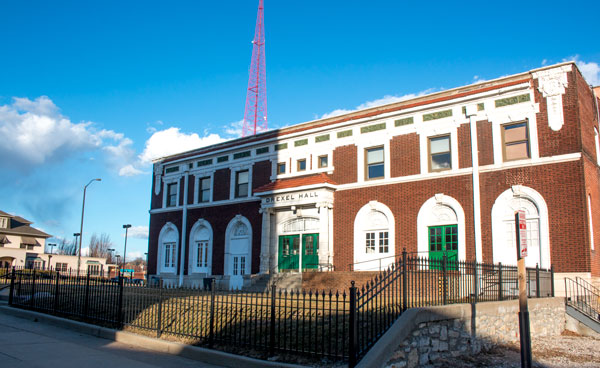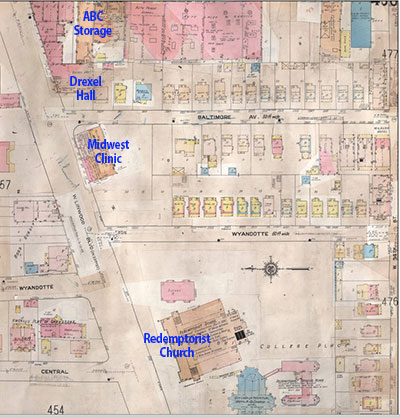
It would be easy to drive past Drexel Hall at the corner of Linwood and Baltimore daily without knowing the layers of history within its walls. Beginning with its unusual beginnings as a spur-of-the-moment purchase by a shrewd businesswoman, to its early days of concerts, dances, and suffrage association meetings, to the fiery union rallies of the 1960s, few buildings in all of Kansas City have facilitated more important cultural, political and social events.
As part of our Uncovering History Project, the Midtown KC Post is examining each block in Midtown. A set of 1940 tax assessment photos is available for many blocks.

This 1909-1950 Sanborn Fire Insurance map shows Drexel Hall just east of Redemptorist Church.
Drexel Hall takes its name from the woman who built it, Barbara Drexel Bescher, who was recognized as a savvy businesswoman as far back as 1915. Bescher was an immigrant from Austria. Her first husband, John, opened a grocery store at 15th and Main in 1870. But in 1896, the two divorced, with Barbara telling the court her husband had abandoned her nine years earlier and did not contribute to her support.
In a 1915 Kansas City Star profile, Bescher, then 65, told a reporter how she went from being broke to rich in 20 years. At the time of the divorce, she said, she had $200 and was responsible for seven children.
“So I just took a fresh start and opened a stall in the market to sell vegetables and things. I tended it myself and the children would help me after school. I used to tell them as soon as they’d sell $10 worth I’d give them 50 cents. But, ach, I couldn’t see those children working. It hurt me. So I used to send them home long before they’d sell $10 worth. They joke me now about it and say I did it to keep from paying them fifty cents. We’ve got lots of jokes in our family like that. It was always fun for us.”
With a lot of hard work, the market stall was a success. Then, one day, Bescher remembered later, she was driving along Hunter Avenue (an earlier name for Linwood Boulevard) and saw a lot for sale.
“I liked the look of the place and thought it would be a coming district,” she said.
The owners wanted $7000; she offered $6,500, and they settled for $6,750 that same day. Soon, the original owners were back, telling Bescher they had sold too cheaply. But she kept the land and built Drexel Hall on it. By 1915, it was bringing in $500 a month.
Twenty years later, she had made a fortune of $100,000, profits from her city market fruit and vegetable stand, the management of Drexel Hall, and other business ventures.
An Important Midtown Gathering Place for Decades
Bescher may have seen before others that the new suburbs developing south of downtown just after the turn of the 20th century needed entertainment venues. She built a hall large enough to accommodate concerts, dances, and weddings. The main entrance of Drexel Hall faced Baltimore, with additional shops and space with doors on the Linwood side.
Drexel Hall became a vital spot. In 1914, for example, the Miss Barstow School (then located on Westport Road near Main Street) held a concert in the hall.
“Many lovers of music have been wishing all winter that the English sisters, the Misses Fullers of Dorsetshire, whose concerts have been a musical event in many Eastern cities and in Chicago, might come to Kansas City before the season ended. Their wish is to be fulfilled on the evening of Saturday, March 14, at Drexel Hall, where the juniors and seniors of Miss Barstow’s school will present these delightful singers in a program of English, Irish and Scottish songs.”– The Kansas City Star, March 8, 1914
A sampling of other activities in the hall that same year shows its wide-ranging role in Midtown society. Drexel Hall was the location for local suffrage association meetings, the annual Mayflower ball given by the children of the Paschal School of Dancing, Drexel Hall subscription dancing club events, Drama Club plays, Schubert Club concerts, Comedy Club performances, a Boy Scouts camp benefit, lectures and concerts supporting music appreciation, and sorority meetings. Miss Helen Thome’s dance studio was also there before moving to Westport Road.
In the 1960s, Drexel Hall became a popular venue for the labor movement and political rallies. The Commercial Telegraph Workers voted to strike against Western Union; the Retail Clerks International Union agreed to strike against Katz Drugstores; Milgram’s workers organized; and the UAW met in Drexel Hall. At the same time, local residents held card parties and the Unidentified Flying Objects Society held regular meetings.
Drexel Hall has recently been used as a wedding venue. The Kansas City Irish Center is also currently using space in the Drexel building.
Pingback: Irish Center moving to Midtown permanently, hosting Winterfest on Saturday | Midtown KC Post